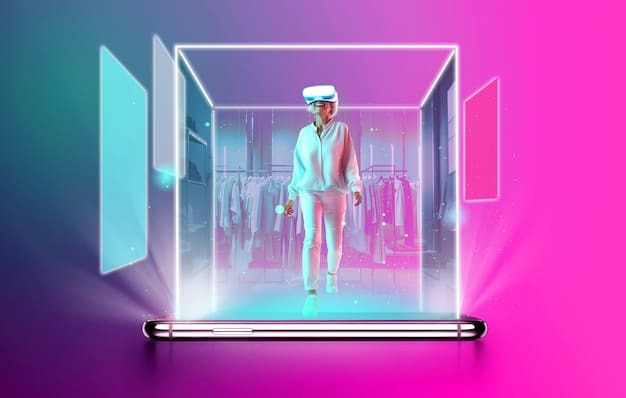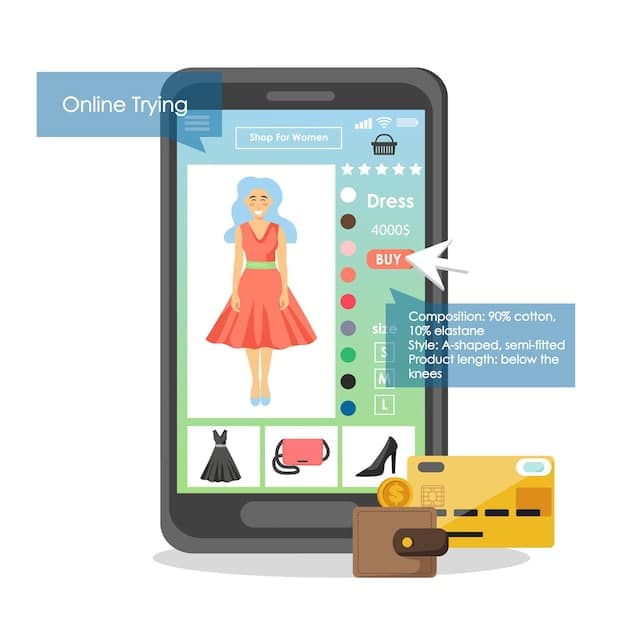Mobile Commerce Trends: Top 5 Shopping Trends in the US for 2025

In 2025, mobile commerce in the US is expected to be shaped by augmented reality, personalized experiences, voice commerce, seamless omnichannel integration, and advanced data analytics, driving innovation and transforming how consumers shop on their mobile devices.
Get ready to explore the future of shopping! The Mobile Commerce Trends: What are the Top 5 Mobile Shopping Trends to Watch Out for in the US in 2025? are set to revolutionize how we buy and sell, creating more immersive and convenient experiences for consumers.
The Rise of Augmented Reality (AR) in Mobile Shopping
Augmented reality is poised to transform the mobile shopping experience by allowing customers to visualize products in their own environment before making a purchase. This technology bridges the gap between online and in-store shopping, providing a more engaging and informed buying process.
Enhancing the Shopping Experience with AR
AR applications can overlay digital images of products onto real-world settings using a smartphone’s camera. For example, a furniture retailer might allow customers to see how a couch would look in their living room before buying it.
The Benefits of AR in Mobile Commerce
By providing a more realistic and interactive shopping experience, AR can reduce the uncertainty associated with online purchases, leading to increased customer satisfaction and fewer returns.
- Improved product visualization and decision-making.
- Increased engagement and time spent on the mobile app.
- Reduction in return rates due to better purchase satisfaction.
- Competitive advantage by offering a unique and innovative shopping experience.
Retailers who adopt AR technology will be well-positioned to capture a larger share of the mobile commerce market in 2025. The ability to provide customers with a virtual “try-before-you-buy” experience will be a key differentiator.
Personalized Mobile Shopping Experiences
Personalization is becoming increasingly important for mobile shoppers. Customers expect retailers to understand their preferences and offer tailored product recommendations and promotions. In 2025, advanced data analytics and AI will enable more sophisticated personalization strategies.
Leveraging Data for Personalization
Retailers can use data on past purchases, browsing history, and demographic information to create personalized shopping experiences. This can include customized product recommendations, targeted advertising, and personalized email marketing.
The Impact of AI on Personalization
Artificial intelligence algorithms can analyze vast amounts of data to identify patterns and predict customer behavior. This allows retailers to deliver highly relevant offers and recommendations in real-time.

- Increased customer loyalty through personalized offers.
- Higher conversion rates due to relevant product recommendations.
- Improved customer satisfaction stemming from a better shopping experience.
- Competitive edge with tailored shopping journeys.
The future of mobile commerce will be defined by how well retailers can personalize the shopping experience for each individual customer. Those who master this will see significant gains in customer engagement and sales.
The Growing Influence of Voice Commerce
Voice-activated assistants like Amazon Alexa and Google Assistant are making it easier for consumers to shop using their voice. This trend is expected to continue to grow in 2025, as more people become comfortable with voice commerce.
The Convenience of Voice Shopping
Voice commerce allows customers to make purchases without having to navigate a mobile app or website. They can simply speak commands to their voice assistant, such as “Order more paper towels” or “Buy a new pair of sneakers.”
Optimizing for Voice Search
Retailers need to optimize their product listings for voice search to ensure that their products are easily discoverable by voice assistants. This includes using natural language keywords and providing detailed product descriptions.
To succeed in the voice commerce space, businesses need to focus on creating seamless, intuitive voice-activated shopping experiences. The key is to make it as easy as possible for customers to find and purchase what they need using their voice.
Seamless Omnichannel Integration
In 2025, consumers will expect a seamless shopping experience across all channels, including mobile, web, and in-store. Retailers need to integrate their mobile commerce platforms with their other channels to provide a consistent and unified experience.
Creating a Unified Shopping Experience
Omnichannel integration involves connecting all of a retailer’s channels so that customers can easily switch between them. For example, a customer might start shopping on their mobile app, add items to their cart, and then complete the purchase in-store.
The Benefits of Omnichannel Integration
Retailers with strong omnichannel capabilities can provide a more convenient and personalized shopping experience, leading to increased customer loyalty and sales. This includes features like click-and-collect, in-store returns for online purchases, and real-time inventory updates.

- Enhanced customer experience through seamless channel transitions.
- Improved brand loyalty with consistent service.
- Increased sales from integrated shopping journeys.
- Better data insights across all customer touchpoints.
Those retailers will thrive that can provide a truly connected and seamless shopping experience across all touchpoints. This requires a strategic approach to technology and a commitment to customer-centric design.
Advanced Data Analytics and AI-Driven Insights
Data analytics and artificial intelligence (AI) will play a crucial role in shaping mobile commerce trends in 2025. Retailers will leverage advanced analytics tools to gain deeper insights into customer behavior and preferences, enabling them to make more informed business decisions.
Predictive Analytics for Mobile Commerce
Predictive analytics can help retailers forecast demand, optimize pricing, and personalize marketing campaigns. By analyzing historical data and current trends, retailers can anticipate future customer needs and tailor their offerings accordingly.
AI-Powered Customer Service
AI-powered chatbots and virtual assistants can provide instant customer support on mobile apps, answering questions, resolving issues, and guiding customers through the purchase process. This can improve customer satisfaction and reduce the workload of human customer service agents.
By harnessing the power of data analytics and AI, retailers can gain a competitive edge in the mobile commerce market. The ability to understand customer behavior and anticipate future trends will be critical for success.
| Key Point | Brief Description |
|---|---|
| 📱 AR Integration | Augmented Reality for virtual try-ons and better product visualization. |
| 🛍️ Personalized Experience | Tailored product recommendations and targeted promotions. |
| 🔊 Voice Commerce | Voice-activated shopping via assistants like Alexa and Google Assistant. |
| 📊 Advanced Analytics | AI-driven insights to optimize pricing and customer service. |
Frequently Asked Questions
▼
Augmented reality will enable customers to visualize products in their real-world environments before purchasing, enhancing the shopping experience and reducing uncertainty.
▼
Personalization provides customized product recommendations and targeted promotions based on customer data, enhancing customer loyalty and conversion rates.
▼
Voice commerce will make shopping more convenient, allowing customers to make purchases through voice commands using assistants like Alexa and Google Assistant.
▼
Omnichannel integration ensures a consistent shopping experience across all channels, enhancing customer satisfaction and driving sales through features like click-and-collect.
▼
Data analytics and AI provide insights into customer behavior, enabling predictive analytics, personalized marketing, and AI-powered customer service on mobile apps.
Conclusion
As we look ahead to 2025, the mobile commerce landscape in the US promises to be transformed by trends like augmented reality, personalized experiences, voice commerce, omnichannel integration, and advanced data analytics. These innovations offer retailers unprecedented opportunities to enhance customer engagement, drive sales, and stay ahead in an increasingly competitive market. By embracing these trends, businesses can create more immersive, convenient, and personalized shopping experiences for their customers, paving the way for success in the future of mobile commerce.





